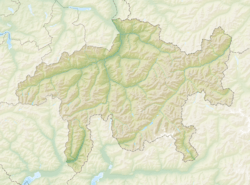Braggio facts for kids
Quick facts for kids
Braggio
|
||
|---|---|---|
|
||
| Country | Switzerland | |
| Canton | Graubünden | |
| District | Moesa | |
| Area | ||
| • Total | 6.91 km2 (2.67 sq mi) | |
| Elevation | 1,298 m (4,259 ft) | |
| Population
(Dec 2013)
|
||
| • Total | 51 | |
| • Density | 7.38/km2 (19.12/sq mi) | |
| Postal code |
6544
|
|
| Surrounded by | Arvigo, Buseno, Santa Maria in Calanca, Selma | |
| Twin towns | Dietikon (Switzerland) | |
Braggio was once a small town, or "municipality," in Switzerland. It was located in a part of Switzerland called Graubünden. On January 1, 2015, Braggio joined with some other nearby towns like Arvigo, Cauco, and Selma. Together, they formed a new, larger municipality named Calanca.
Contents
Braggio's Past: A Quick Look at History
Braggio is a very old place. People first wrote about it in the year 1419, calling it Bragio. For a long time, it was part of a bigger area known as Calanca. Then, in 1851, Braggio became its own independent town.
Exploring Braggio's Location and Land
Before it joined with other towns, Braggio covered about 6.9 square kilometers (2.7 square miles). A small part of this land, about 9.6%, was used for farming. Forests covered a large area, about 67.2% of the town.
Only a tiny bit of the land, 0.9%, had buildings or roads. The rest, about 22.4%, was made up of natural features like rivers, glaciers, or mountains. Braggio is located high up on a meadow, about 1,320 meters (4,330 feet) above sea level. You could only reach it by a special cable car, which started running in 1961, or by a narrow walking path.
Who Lived in Braggio? Population Facts
In 2013, Braggio had a population of 51 people. By 2008, about 6.6% of the people living there were from other countries. Over the ten years before 2013, the number of people living in Braggio went down by about 17.6%.
Most people in Braggio spoke Italian in 2000, about 77.4% of the population. German was the second most common language, spoken by 17.7% of residents. A smaller group, 4.8%, spoke French.
Age and Gender in Braggio
In 2000, the population of Braggio was almost evenly split between males and females. About 46.4% were male, and 53.6% were female. There were 8 children under 9 years old, making up 12.9% of the population.
Seven teenagers, or 11.3%, were between 10 and 14 years old. Only one teenager was between 15 and 19. Most adults were between 40 and 49 years old, with 16 people in this group. There were also 6 people aged 60 to 69, and 10 people aged 70 to 89.
Education and Jobs in Braggio
People in Switzerland generally have good education. In Braggio, about 56.7% of adults (aged 25-64) had finished high school or gone on to higher education, like university.
Braggio had a low unemployment rate of 1.23%. In 2005, 13 people worked in farming, which is the "primary economic sector." Six people worked in the "secondary sector," which includes things like manufacturing. Two people worked in the "tertiary sector," which involves services.
Braggio's Population Over Time
Here's how Braggio's population changed over many years:
| year | population |
|---|---|
| 1850 | 123 |
| 1900 | 108 |
| 1950 | 98 |
| 1990 | 54 |
| 2000 | 62 |
Braggio's Weather Patterns
Braggio usually has about 97.4 days of rain each year. On average, it gets about 1,645 millimeters (64.8 inches) of rain and snow combined. May is the wettest month, with about 204 millimeters (8 inches) of rain over 12 days. The driest month is December, with about 55 millimeters (2.2 inches) of rain over 12 days.
See also
 In Spanish: Braggio para niños
In Spanish: Braggio para niños




